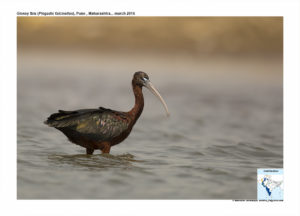Glossy lbis

Glossy Ibis Plegadis falcinellus
Etymology:
- Plegadis : Greek word for Sickle
- Falcinellus: Italian name for Glossy Ibis derived from falcis -sickle
Vernacular Names: Hindi: Kawari, Kowar, Chhota baza, Pun: Chamkila buza, Ass: Jakmaki akohi bog, Ben: Kachia tora, Guj: Pan/Nani kankanasar, Mar: Mor sherati, Ta: Karuppu kottan, Anthril paravai, Te: That kankanam, Mal: Chemban ibis, Sinh: Ratu dae tuduwa
Distribution in India: Resident in parts of West India and winter visitor in West and South India.
Description:Size of 48·5–66 cm; wt. of 350–840 g; wingspan of 80–95 cm. The breeding adults have reddish-brown bodies and shiny bottle-green wings. Non-breeders and juveniles have duller bodies. They have a brownish bill, dark facial skin bordered above and below in blue-gray (non-breeding) to cobalt blue (breeding), and red-brown legs.
Habitat:It is found in shallow lakes, swamps, lagoons, sewage ponds, rivers, floodplains, wet meadows, rice fields and irrigated cultivation. It Nests in freshwater or brackish wetlands, usually in tall, dense stands of reeds or rushes, or in low trees or bushes over or near water.
Food Habits: It eats adults and larvae of water beetles, dragonflies, caddis flies, locusts, flies and other insects; also molluscs, crustaceans, worms, leeches, frogs, tadpoles and small fish and Snakes. It forages in small flocks; walks slowly and probes bill into mud and shallow water, or takes prey from surface; sometimes submerges head completely, and occasionally runs after prey.
Breeding Habits: They breed in South India in Jan-Mar and April-May in Spain, Cuba and America. The breeding is colonial, alongside other water birds such as herons and storks. The nest is a compact platform of twigs or reeds, lined with leaves and other soft vegetation in a low shrub.They lay a clutch of 3–4 eggs .The incubation period is 20–23 days. The fledging period is 25–28 days.